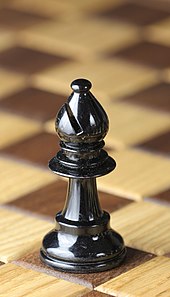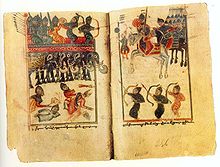Bishop
The bishop (♗ ♝) (formerly called bishop ) is a minor Western chess piece worth approximately three pawns. It moves diagonally, cannot jump intervening pieces, and captures taking the place occupied by the opposing piece. Due to the characteristics of its movement, it has the deficiency of the color weakness because its movement is limited to the color of the square in which the game starts.
Initially, the bishop was not part of Chaturanga or its Arabic successor Shatranj—oriental board games from which chess originated—and was included in the game approximately in the twelfth century, already in Europe. Its predecessor, the al-fil, had its name attached to the word Elephant and historians indicate that the change of the piece and, in some countries, its denomination (for example, in English it is bishop, and in Portuguese bispo) was due to the influence of the Catholic Church in the Middle Ages and the similarity of the Arab abstract piece with the miter used by the bishops of the time.
Currently, most chess diagrams depict the bishop as the figure or icon of a miter with its two footlike pretenses; but there are diagrams where this piece is represented by a helmet with a visor or helmet of armor of a medieval knight.
In the opening, the bishops usually play defense roles for the pawns in the center and, in the hypermodern concept, they are preferred to develop into fianchetto to control the central squares at a distance. In the middle and endgame its value increases as the positions become more open, especially if the player still has the bishop pair. There are specific studies of endgames involving the bishop: endgames with opposite-colored bishops have a great tendency to draw even with great material superiority on the strong side; while possession of a passed pawn gives a great advantage, particularly when the promotion square is the color of the bishop and the king can protect the pawn up to the seventh rank.
History and etymology
The word bishop comes from the Arabic al-fil (الفيل), whose meaning is “the elephant”. On the other hand, the predecessor of the bishop in the Shatranj was bishop or Pīl, which could move two squares diagonally, skipping the first, even when occupied. Consequently, each bishop was restricted to eight squares on the board and could not attack the opponent's bishop. The modern bishop first emerged in about the 12th century in the Messenger's chess. The piece with this movement, called cocatriz or crocodile, was part of the Grande Acedrez in the game book compiled in 1283 by King Alfonso X of Castile. The game is credited with Indian origin, until then a vague term.
About half a century later, Muhammad ibn Mahmud al-Āmulī in his book Treasures of Science describes a form of expanded chess with two pieces that "moved like the rook but in a different way. oblique". This piece was called a dabbabah, the name used for a portable roof used by soldiers attacking a wall protected by archers, boiling liquids, and other military artifacts used by the defenders. Two books from the end of the 15th century describe the new movement of the bishop: the Libre Del jochs partits dels schachs em nombre de 100 by Francesc Vicent, lost in 1811 during a looting of the Monastery by Napoleon's soldiers de Montserrat, and Repetition of loves and art of chess with CL game games by Luis Ramírez de Lucena, printed in the city of Salamanca and dedicated to the recently deceased Prince Don Juan, son of the Catholic Monarchs of Castile. Instead of jumping just one square, he could go the diagonal path as long as his path wasn't impeded.
The origin of the piece is unknown. It is believed to have been caused by the abstract format of the Pīl, with two bumps at the top, which originally symbolized the tusks of an elephant, reminiscent of the bishops' miter. Part name of the Arabic term, different from the other parts, was not homogeneous. In Spain, directly influenced by the Arabs, the original name "alfil" was retained, while in Italy it was modified to Alfiere, that is, a standard-bearer. In France, the piece was initially named as Aufin and later as Fou, meaning court jester, which remains to this day. In Germany and Denmark the piece is used to mean runner, Läufer and Looper, respectively. In the Netherlands, due to Norse influence, the piece acquired the meaning of bishop, which probably had an influence on the position of the work piece next to the king on the board and the status of the Church as the main adviser to the monarchy.
Movement and relative value
When starting a game, each player has a pair of scripts arranged in c1 and f1 for the white and c8 and f8 for the blacks. His movement is oblique, moving in a straight line on the board diagonals. The number of scales that can attack an empty board ranges from 7 to 13, being more effective in the center of the board. It cannot jump or pieces of the same color or those of the adversary and its capture of movement consists in occupying the scake of the adverse piece. According to the FIDE, in Portuguese and Spanish speaking countries the bishop must be represented by the letter B in the algebraic notation of chess that will be used in the official tournaments. In journals and literature, the use of images or diagrams is recommended (![]() and
and ![]() )
)
Typically, the relative value of the bishop is estimated to be between 3 and 3.5 points above the reference value of a pawn, although they are considered to be more valuable in pairs. A pair of bishops is on average half a point more valuable, which is enough considering value and position, and enough to impress most positional considerations. This superiority is surprisingly neglected by grandmasters, who often give up the bishop pair in the opening for the chance to double a pawn or gain a bit of development, factors that are not as valuable as half a point.
Strategy involving the Bishop
Good Bishop and Bad Bishop
A chess player with a bishop should generally place his pawns on the colored squares in front of the bishop so that he can move between the pawn structure and thus be able to control more squares and attack the opposing pawns on the Pawn squares controlled by the bishop. When the bishop can maintain its mobility it is called a good bishop.
In situations where pawns are on squares of the same color as the bishop, this is called bad bishop or high bishop, as its mobility is affected compromised by the pawn chain, being inferior to a knight late in a game. However, a bad bishop is not necessarily a disadvantage, especially if it were in front of the pawn chain and on top of that, also a bad bishop. bad can be advantageous in an ending with opposite colored edges. Even when limited to passive positions, a bishop can be useful in defensive roles, GM Mihai Şubă saying that "bad bishops protect good pawns".
Opposite colored bishop
When a player has only one bishop and the opponent also has one so that these squares are on opposite colored squares, these pieces cannot directly fight for control of the squares due to color weakness. In the final stage, this disadvantage can be decisive, because even if one of the players had two pawns he would not win.
Comparison with the Horse
The bishop has about the same relative value as the knights, however, depending on the game situation it can have a clear advantage. Inexperienced chess players tend to underestimate the bishop relative to the knight due to its ability to use the fork tactic. In addition, the knights do not suffer from the weakness of the color, which allows them to reach all the squares on the board.
Generally, two bishops have greater relative strength in the late game when there are few pieces left on the board and more diagonals are available for them to move, being able to get from one corner of the board to the other in one go movement, while the Knight needs more to do it, and they don't suffer from the flush weakness. However, this feature is not necessarily an advantage, as it depends on other factors, such as the pawn structure. The strength of the pair of blades was initially studied by Louis Paulsen and Wilhelm Steinitz, who in their games sought to explore the mobility of the pieces in opposition to the opponent's knight. The exchange of a knight for a bishop is called a minor quality, a term coined. by Siegbert Tarrasch. In certain positions, a bishop can also lose a tempo through a waiting move, thus avoiding Zugzwang positions, the knight being unable to perform this tactic. Lastly, the bishop is capable of employing tactics such as the spike and the pin, the knight being incapable of either.
On the other hand, during the opening and middlegame a bishop may have its movements restricted by its own or opponent's pawns, therefore below the knight it can jump over the pieces becoming more active. Opportunities for applying spikes are common for knights, often making it possible to gain material, while opportunities to do so are rare for the bishop due to its oblique movement. An example is given in the continuation of the Ruy Lopez Opening: 1.e4 e5 2.Nf3 Nc6 3.Bb5 a6 4.Ba4 Nf6 5.0-0 b5 6.Bb3 Be7?! 7.d4 d6 8.c3 Bg4 9.h3!? Bxf3 10.Qxf3 exd4 11.Qg3 g6 12.Bh6!.
The sacrifice of the pair of bishops
The sacrifice of the two bishops is a resource that is used to open the files on the opponent's king, usually carried out on the king's side. It is an active sacrifice in which the attacker captures pawns from the opposing kings. g and h files, opening space for a series of queen checks and rooks. The first record occurred in the Lasker-Bauer game (Amsterdam-1899).
1.f4 d5 2.e3 Nf6 3.b3 e6 4.Bb2 Be7 5.Bd3 b6 6.Nc3 Bb7 7.Nf3 Nbd7 8.O-O O-O 9.Ne2 c5 10.Ng3 Qc7 11.Ne5 Nxe5 12.Bxe5 Qc6 13.Qe2 a6?? 14.Nh5 Nxh5 15.Bxh7+ Kxh7 16.Qxh5+ Kg8 17.Bxg7 Kxg7 18.Qg4+ Kh7 19.Rf3 e5 20.Rh3+ Qh6 21.Rxh6+ Kxh6 22.Qd7 Bf6 23.Qxb7 Kg7 24.Rf1 Rab8 25.Qd7 Rfd8 26. Qg4+ Kf8 27.fxe5 Bg7 28.e6 Rb7 29.Qg6 f6 30.Rxf6+ Bxf6 31.Qxf6+ Ke8 32.Qh8+ Ke7 33.Qg7+ Kxe6 34.Qxb7 Rd6 35.Qxa6 d4 36.exd4 cxd4 37.h4 d3 38. Qxd3 and Black resigns.
Contenido relacionado
Annex: Archery at the 1908 London Olympics
The well and the pendulum
The Lord of the Rings (disambiguation)







